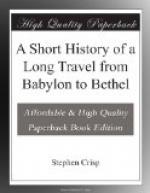INTRODUCTION
Writings of the first Quakers, even minor writings, often kindle in us today an ardor to seek what they sought and to find what they found. The excellent book by Luella M. Wright entitled “The Literary Life of the Early Friends, 1650-1725” is a pleasant and convenient introduction to these numerous and often lengthy productions of which 2600 have been listed for the first 75 years. Among them all, Luella Wright singles out one allegory; the only one, and it remained unpublished fully two decades after its composition. Why was this? Was it because, though the author was as sound a thinker and as persuasive an author as any among the followers of George Fox, an imaginary pilgrimage was inherently suspect, while the record of actual experiences in the form of a journal was not? Be this as it may, the slight loosening of standards with the opening of the eighteenth century allowed the “Second Day’s Morning Meeting,” which then censored Quaker manuscripts, to approve for printing “A Short History of a Long Travel from Babylon to Bethel.” It was put out in 1711. How entertaining it would be to know the number of copies that were printed in that first edition.
Stephen Crisp was a famous preacher. “He had a gift of utterance beyond many” said his brethren in Colchester at the time of his decease. He was listened to by many outside the Society of Friends and his sermons, together with the prayer at the end of every one of them, were “exactly taken in character,” that is in shorthand “as they were delivered ... in the meeting houses of the people called Quakers.”
Though Stephen Crisp’s letters, sermons, and journal promptly appeared in print and were widely circulated, the “Short History” remained after his death in the bundle of his papers in Colchester. John Bunyan’s famous book “The Pilgrim’s Progress” had appeared with its primitive woodcuts in 1678. It received immediate recognition and in due time was acclaimed the greatest religious book produced in England. Stephen Crisp’s allegory is minimal besides it (some 30 pages as against 207), but the “Long Travel” retains significance because of its more modern point of view.
This tiny tract usually printed in pocket size (2” x 3”) sometimes with a passage from the author’s journal included, was reprinted more than twenty times. I happened upon it in the Friends Historical Library at Swarthmore College twenty years ago. They then had four copies. Today they have more than a dozen.
How does Stephen Crisp’s theology differ from that of Bunyan’s? In the first place, while Crisp’s pilgrim starts off with a pack on his back of luggage for his journey, Bunyan’s pilgrim had as his pack the burden of guilt which is original sin. Second, Crisp’s pilgrim soon gives up confidence in human leadership having discovered a measure of the Light. Third, he crosses the river early on his journey, whereas for Bunyan’s




